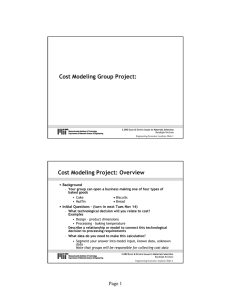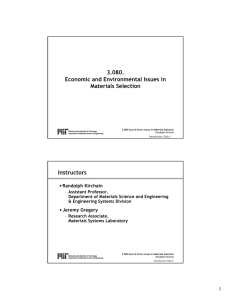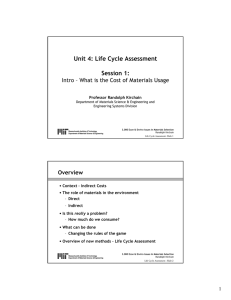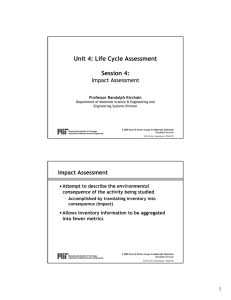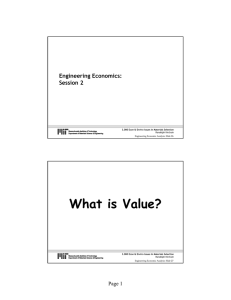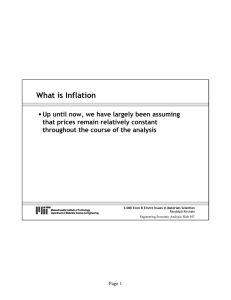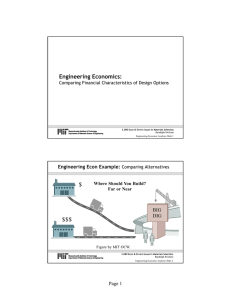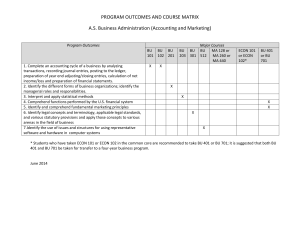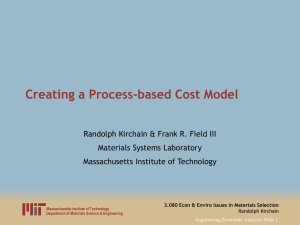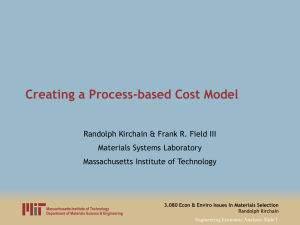Document 13553720
advertisement
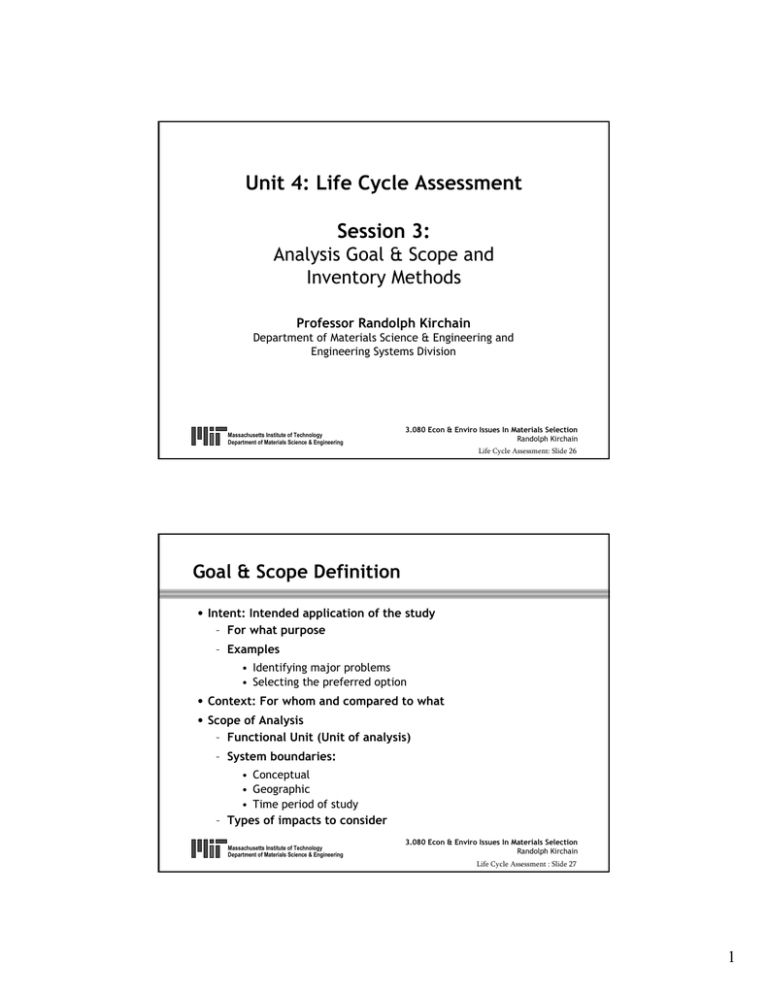
Unit 4: Life Cycle Assessment Session 3: Analysis Goal & Scope and Inventory Methods Professor Randolph Kirchain Department of Materials Science & Engineering and Engineering Systems Division Massachusetts Institute of Technology Department of Materials Science & Engineering 3.080 Econ & Enviro Issues In Materials Selection Randolph Kirchain Life Cycle Assessment: Slide 26 Goal & Scope Definition • Intent: Intended application of the study – For what purpose – Examples • Identifying major problems • Selecting the preferred option • Context: For whom and compared to what • Scope of Analysis – Functional Unit (Unit of analysis) – System boundaries: • Conceptual • Geographic • Time period of study – Types of impacts to consider Massachusetts Institute of Technology Department of Materials Science & Engineering 3.080 Econ & Enviro Issues In Materials Selection Randolph Kirchain Life Cycle Assessment : Slide 27 1 Goal & Scope Definition: How far do we go? • Defining boundaries – No theoretical basis for exclusion – Often broken at environmental flows or economic flows of + value – Generally includes only processes in direct contact with product & raw materials entering that product • Example: Oil Use – Combustion • If electricity, consider: conversion efficiency & transmission eff. – Extraction – Transport – Refining Massachusetts Institute of Technology Department of Materials Science & Engineering 3.080 Econ & Enviro Issues In Materials Selection Randolph Kirchain Life Cycle Assessment : Slide 28 Inventory Analysis • Building a system model of the flows within your system – System boundaries and flow types defined in Goal & Scope – Typically includes only environmentally relevant flows • Steps – Catalog what activities to include (draw a flowchart) – Data collection – Computation of flows per unit of analysis • Serious challenges around allocation Massachusetts Institute of Technology Department of Materials Science & Engineering 3.080 Econ & Enviro Issues In Materials Selection Randolph Kirchain Life Cycle Assessment : Slide 29 2 Inventory Analysis: Data collection • Data collection – Inflows of materials – Inflows of energy – Releases to land, water and air • Typically the most time consuming stage • Data sources – Scientific literature, Published studies – Industry & government records – Industry associations – Private consultants Massachusetts Institute of Technology Department of Materials Science & Engineering 3.080 Econ & Enviro Issues In Materials Selection Randolph Kirchain Life Cycle Assessment : Slide 30 Product Production Overview • Product P produced in plant C – C: Metal sheets cut and pressed to make P • Plant B delivers metal sheets to plant C – B: Ingots melted and rolled into sheets • Ingots come from plant A – A: Mineral is extracted, turned into metal, cast into ingots Massachusetts Institute of Technology Department of Materials Science & Engineering 3.080 Econ & Enviro Issues In Materials Selection Randolph Kirchain Life Cycle Assessment : Slide 31 3 Product Production Details • Transport: – A to B: 1000 km, by truck – B to C: 0 km (adjacent) • Scrap: – Process scrap from C returned to B for remelting • Product P: – Weight = 40 g – 6 m2 metal sheet needed to make 1,000 – Metal thickness = 1.0 mm – Metal Density = 8,000 kg/m3 Massachusetts Institute of Technology Department of Materials Science & Engineering 3.080 Econ & Enviro Issues In Materials Selection Randolph Kirchain Life Cycle Assessment : Slide 32 Environmental Data – Plant A Summary Products Raw Material Inputs/Outputs Description Total Annual Production Use of raw material Use of energy in the process Emissions to air Emissions to water Non-hazardous solid waste Massachusetts Institute of Technology Department of Materials Science & Engineering Metal ingots Mineral Quantity 1200 4800 1.20E+07 600 600 3800 Units tonnes/year tonnes/year MJ/year kg/year kg/year tonnes/year Details Product A Raw A Oil Combustion HCL Cu Solid Waste 3.080 Econ & Enviro Issues In Materials Selection Randolph Kirchain Life Cycle Assessment : Slide 33 4 Environmental Data – Plant B Summary Products Raw Material Inputs/Outputs Description Total Annual Production Use of raw material - ingots Use of raw material - scrap Use of energy - smelting Use of energy - rolling Emissions to air Massachusetts Institute of Technology Department of Materials Science & Engineering Metal Sheets Metal ingots and process scrap Quantity 1600 900 700 3.04E+06 1.76E+06 480 Units tonnes/year tonnes/year tonnes/year MJ/year MJ/year kg/year Details Sheets Ingots Scrap Electricity Electricity HC 3.080 Econ & Enviro Issues In Materials Selection Randolph Kirchain Life Cycle Assessment : Slide 34 Environmental Data – Plant C Summary Products Raw Material Inputs/Outputs Description Total Annual Production Use of raw material Use of energy - oil Use of energy - electricity Emissions to air Process Scrap for Recycling Massachusetts Institute of Technology Department of Materials Science & Engineering Consumer Product P Metal Sheets Quantity 400 480 3.00E+05 1.20E+06 250 80 Units tonnes/year tonnes/year MJ/year MJ/year kg/year tonnes/year Details Product P Sheets Oil Electricity HC Scrap 3.080 Econ & Enviro Issues In Materials Selection Randolph Kirchain Life Cycle Assessment : Slide 35 5 Environmental Data – Transportation and Energy Production Transportation – Diesel Fuel Energy Driving Conditions Energy Consumption Units Long Haul 1 MJ/tonne-km City Traffic 2.7 MJ/tonne-km Energy Production Emissions Emissions (g/MJ fuel consumed) Substance Oil Diesel HC 0.018 0.208 NOx 0.15 1.3 CO2 79.8 78.6 3.080 Econ & Enviro Issues In Materials Selection Randolph Kirchain Massachusetts Institute of Technology Department of Materials Science & Engineering Life Cycle Assessment : Slide 36 Flowchart Mineral Ingots A TransTransport Ingots Metal Sheets B C Product P Process Scrap Massachusetts Institute of Technology Department of Materials Science & Engineering 3.080 Econ & Enviro Issues In Materials Selection Randolph Kirchain Life Cycle Assessment : Slide 37 6 Process Emissions 200 180 160 140 Output per 120 functional 100 unit (grams) 80 60 40 20 0 Design A Design B HCl Massachusetts Institute of Technology Department of Materials Science & Engineering Cu Solid Waste (kg) HC HC NOx CO2 (kg) 3.080 Econ & Enviro Issues In Materials Selection Randolph Kirchain Life Cycle Assessment : Slide 38 7
